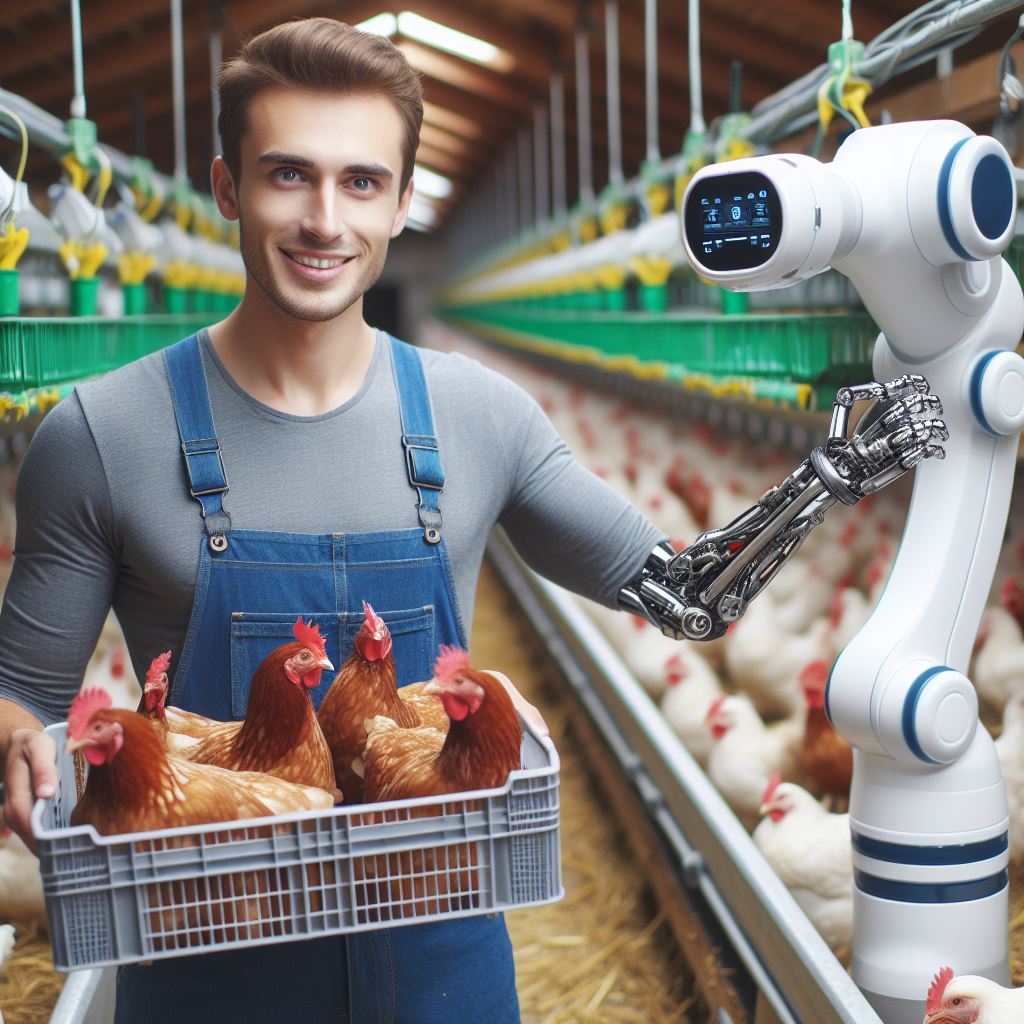Introduction
Importance of vaccines for healthy cattle herds
Vaccines are essential for the well-being and productivity of cattle herds.
With the increasing prevalence of infectious diseases, it is crucial to protect these animals from potential health risks.
Vaccination programs help prevent diseases such as bovine respiratory disease, clostridial infections, and reproductive disorders.
By administering vaccines to cattle, farmers can enhance the overall health status of their herds and minimize economic losses.
Purpose of the blog post
The purpose of this blog post is to educate cattle farmers and anyone involved in livestock management about the significance of vaccines.
It aims to provide a comprehensive understanding of the benefits of vaccination and the various vaccines available for cattle.
By highlighting the importance of a proactive approach to herd health, the post seeks to encourage farmers to incorporate vaccination programs into their management practices.
The blog post will delve into the different types of vaccines, including live and inactivated vaccines, and discuss their effectiveness in preventing specific diseases.
It will also touch upon the proper administration techniques and the recommended vaccination schedules.
By providing this information, the post aims to empower cattle farmers to make informed decisions regarding the health and welfare of their herds.
Therefore, vaccines are essential tools in maintaining the health of cattle herds.
This blog post intends to emphasize their importance, educate farmers about the different vaccines available, and encourage proactive vaccination practices.
By implementing proper vaccination protocols, cattle farmers can ensure the long-term health and productivity of their herds.
Common diseases in cattle
Brief overview of common diseases
- Bovine respiratory disease: This disease affects the respiratory system of cattle, leading to pneumonia and decreased productivity.
- Foot and mouth disease: Highly contagious viral disease causing fever, blisters, and lameness in cattle.
- Mastitis: Inflammation of the udder, most commonly caused by bacterial infection, leading to reduced milk production.
- Brucellosis: Infectious disease caused by bacteria, affecting reproduction and causing abortions in cattle.
- Bovine viral diarrhea: Viral infection causing diarrhea, fever, and reproductive issues, leading to economic losses.
- Blackleg: Bacterial infection causing sudden death and muscular swelling in young cattle.
- Haemorrhagic septicemia: Rapidly fatal bacterial disease causing high fever, respiratory distress, and sudden death.
Impact of diseases on cattle health and productivity
- Economic losses: Common diseases in cattle result in significant economic losses for farmers due to decreased productivity, treatment costs, and mortality rates.
- Reduced milk production: Mastitis and bovine viral diarrhea can lead to reduced milk production, impacting the dairy industry’s profitability.
- Reproductive issues: Diseases like brucellosis and bovine viral diarrhea can cause abortions, infertility, and decreased calf survival, affecting breeding programs.
- Weakened immune system: Common diseases can weaken the immune system of cattle, making them more susceptible to other infections and reducing overall health.
- Stress and discomfort: Animals suffering from diseases experience stress and discomfort, leading to poor welfare and reduced quality of life.
- Increased antibiotic use: Treating common diseases often requires the use of antibiotics, leading to the risk of antimicrobial resistance and environmental contamination.
- Trade restrictions: Some diseases, like foot and mouth disease, can result in trade restrictions, limiting exports and negatively impacting the industry’s economy.
To maintain healthy cattle herds, it is crucial to prioritize prevention through vaccination programs.
Vaccines play a vital role in managing and controlling the common diseases outlined above.
Transform Your Agribusiness
Unlock your farm's potential with expert advice tailored to your needs. Get actionable steps that drive real results.
Get StartedThese vaccines stimulate the immune system, providing protection against specific pathogens.
By vaccinating cattle, farmers can significantly reduce the incidence and severity of diseases, ensuring the health and productivity of their herds.
It is important to consult with a veterinarian to determine the most appropriate vaccination schedule and vaccines for the specific needs of the herd.
Vaccinations should be administered at the recommended age and frequency to establish effective immunity.
Therefore, common diseases in cattle have a detrimental impact on their health and productivity.
Vaccinations are a crucial tool in preventing and controlling these diseases.
By prioritizing vaccination programs and working closely with veterinarians, farmers can safeguard the well-being and profitability of their cattle herds.
Read: Mobile Apps for Efficient Herd Management
Types of vaccines for cattle
Core vaccines
- Explanation of core vaccines: Core vaccines are vaccines that are recommended for all cattle in a herd.
- Examples of core vaccines: Some common core vaccines for cattle include vaccines for clostridial diseases, respiratory diseases, and reproductive diseases.
- Importance of administering core vaccines to all cattle: Administering core vaccines helps protect the overall health and well-being of the entire cattle herd, preventing the spread of infectious diseases and reducing the risk of outbreaks.
Non-core vaccines
- Explanation of non-core vaccines: Non-core vaccines are vaccines that are only recommended for specific cattle populations based on their health status or risk factors.
- Examples of non-core vaccines: Some examples of non-core vaccines include vaccines for specific respiratory diseases like bovine viral diarrhea and infectious bovine rhinotracheitis.
- Considerations for administering non-core vaccines based on herd health and risk factors: When deciding whether to administer non-core vaccines, it is important to consider factors such as the prevalence of specific diseases in the area, the age and breeding status of the cattle, and the risk of exposure.
Most importantly, vaccines play a crucial role in maintaining the health and productivity of cattle herds.
Core vaccines are recommended for all cattle to protect against common diseases, while non-core vaccines may be necessary based on specific risk factors.
By properly administering vaccines, cattle owners can ensure the overall well-being and profitability of their herds.
Read: Eco-Friendly Livestock Equipment: What’s New?

Essential vaccines for cattle herds
In the intricate tapestry of cattle farming, maintaining herd health is a cornerstone of sustainable practices, and vaccinations stand as a formidable defense against potential diseases.
Let’s delve into the crucial vaccines categorized by disease types, understanding their impact on cattle well-being.
Clostridial Vaccines
Clostridial diseases, encompassing threats like blackleg and tetanus, pose severe risks to cattle.
Vaccines, such as Covexin and Ultrabac, play a pivotal role in preventing these potentially fatal infections.
The significance lies not only in individual protection but in fortifying the collective health of the entire herd.
Bovine Respiratory Disease (BRD) Vaccines
Bovine Respiratory Disease (BRD) emerges as a prevalent and economically impactful respiratory ailment.
Vaccination against BRD, exemplified by vaccines like Bovilis and Pyramid, is indispensable for sustaining the overall health and productivity of the herd.
A proactive approach to respiratory health ensures resilience in the face of potential challenges.
Viral Vaccines
Diseases, including Bovine Viral Diarrhea (BVD) and Infectious Bovine Rhinotracheitis (IBR), can wreak havoc on cattle populations.
Viral vaccines, such as Vista Once and Express FP, are instrumental in establishing herd immunity.
This not only prevents the spread of contagious diseases but also forms a robust defense mechanism against potential viral threats.
Proactive vaccination is not merely a preventive measure; it is a fundamental element of responsible and sustainable cattle farming.
Showcase Your Farming Business
Publish your professional farming services profile on our blog for a one-time fee of $200 and reach a dedicated audience of farmers and agribusiness owners.
Publish Your ProfileThe approach involves understanding the unique disease landscape in a specific region, tailoring vaccination programs accordingly, and staying vigilant against emerging threats.
Collaboration with veterinary professionals is paramount.
Veterinarians, armed with knowledge and experience, help farmers design vaccination strategies that align with the specific needs of their herd.
Regular consultations ensure that vaccination programs remain effective and adaptive to the evolving disease landscape.
Regular vaccinations contribute not only to individual animal well-being but also to the long-term productivity and profitability of the entire cattle operation.
The economic losses associated with disease outbreaks, coupled with the potential for compromised herd health, highlight the pivotal role vaccinations play in maintaining a thriving and resilient cattle population.
In fact, a comprehensive vaccination regimen is a strategic investment in the vitality of cattle herds.
Understanding prevalent diseases, incorporating targeted vaccinations, and collaborating with veterinary professionals form the pillars of a proactive and sustainable approach.
Regular consultations, coupled with a commitment to staying informed about advancements in vaccine technology, ensure that cattle herds stand resilient against potential disease threats, fostering a robust and sustainable future for cattle farming.
Read: Profitable Pig Marketing Strategies
Vaccination schedules and protocols
Vaccination schedules and protocols are crucial in maintaining a healthy cattle herd.
By understanding the factors that influence vaccination schedules, such as age, geographical location, and herd composition, cattle owners can effectively protect their animals from prevalent diseases.
Moreover, implementing recommended vaccination protocols for different stages of cattle life ensures comprehensive protection throughout their lifespan.
Factors influencing vaccination schedules
Factors such as the age of cattle play a significant role in determining the appropriate timing for vaccination.
It is important to provide vaccines at the optimal age to maximize their effectiveness and protect the young animals from potential diseases.
Additionally, the geographical location of the herd should be considered.
Certain regions may have higher prevalence rates of specific diseases, necessitating more targeted vaccinations.
Herd size and composition are also essential factors in developing vaccination protocols.
Large herds may require more comprehensive vaccines to minimize the risk of disease spread, while smaller herds with specific cattle types may have different susceptibility levels and vaccine requirements.
Recommended vaccination protocols for different stages of cattle life
When it comes to specific stages of cattle life, the recommended vaccination protocols differ.
Calves should receive essential vaccines early on, including those for clostridial diseases, respiratory diseases, and scours prevention.
These initial vaccinations provide a foundation of protection to support their overall health.
As cattle reach the weaning stage, their vaccination protocols should be updated to include extended protection against clostridial diseases, respiratory infections, and other prevalent diseases in the region.
This ensures that they can adapt to the changing environmental challenges and prevent outbreaks.
Breeding cows require a different set of vaccines to safeguard their reproductive health.
Diseases like brucellosis and vibriosis can have severe consequences on breeding success and can result in significant reproductive losses.
Vaccinating breeding cows against such diseases is crucial for maintaining a productive herd.
Lastly, bulls also need to be vaccinated to prevent the transmission of diseases during breeding.
Bovine viral diarrhea (BVD) and leptospirosis are common diseases that can be transmitted through bulls.
Vaccinating bulls against these diseases reduces the risk of transmission and ensures the overall health of the herd.
In short, developing appropriate vaccination schedules and protocols for cattle herds is crucial for maintaining their overall health and productivity.
By considering factors such as age, geographical location, and herd composition, cattle owners can minimize disease risks and protect their animals effectively.
Following recommended vaccination protocols for different stages of cattle life ensures comprehensive protection and contributes to the well-being of the entire herd.
Read: Pig Farming: Pasture vs. Indoor
Vaccination challenges and solutions
Proper storage and handling of vaccines
It is important to maintain the cold chain for vaccine efficacy.
Follow these tips for proper vaccine storage:
- Store vaccines in a temperature-controlled refrigerator between 35°F (2°C) and 46°F (8°C).
- Do not freeze vaccines as it can damage their effectiveness.
- Avoid exposure to sunlight or extreme heat.
- Check vaccine expiration dates and discard any expired vaccines.
Vaccination techniques and administration
There are various methods of vaccine administration in cattle.
Follow these best practices for successful vaccination:
- Use proper injection techniques to ensure proper delivery of the vaccine.
- Ensure cleanliness of equipment and use sterile needles for each animal.
- Vaccinate at the recommended age or stage of production for maximum effectiveness.
- Follow label instructions for proper dosage and route of administration.
Monitoring vaccine efficacy and response
There are methods to assess vaccine effectiveness in cattle herds.
Regularly monitor for adverse reactions or lack of response after vaccination:
Showcase Your Farming Business
Publish your professional farming services profile on our blog for a one-time fee of $200 and reach a dedicated audience of farmers and agribusiness owners.
Publish Your Profile- Observe for any abnormal behavior or signs of illness after vaccination.
- Keep records of vaccine administration and monitor the overall health of the herd.
- Consult with a veterinarian if there are any concerns about vaccine efficacy or adverse reactions.
By properly storing and handling vaccines, using appropriate vaccination techniques, and monitoring vaccine efficacy and response, cattle herds can maintain a high level of health and productivity.
Conclusion
Essential vaccines play a crucial role in maintaining the health of cattle herds.
Cattle owners and farmers should prioritize vaccination programs to ensure the well-being of their animals.
Essential vaccines are vital for maintaining the health and well-being of cattle herds.
Vaccinations protect against various diseases and help prevent outbreaks that could have devastating consequences.
It is crucial for cattle owners and farmers to prioritize vaccination programs to safeguard the health of their animals and ensure the sustainability of their herds.
By staying proactive and implementing proper vaccination protocols, cattle can thrive in a disease-resistant environment, resulting in increased productivity and profitability for farmers.
Vaccines are an essential investment in the long-term health and success of cattle herds.




